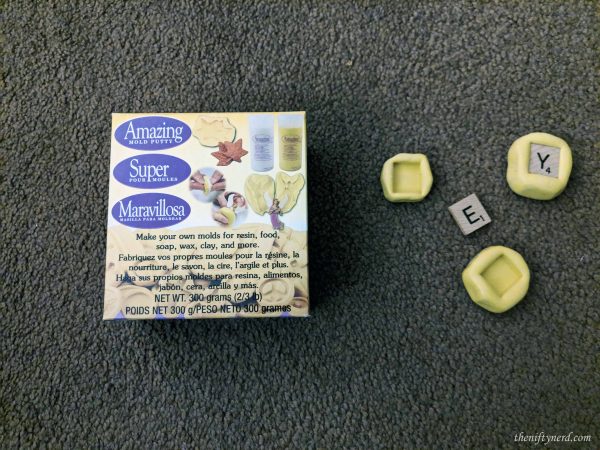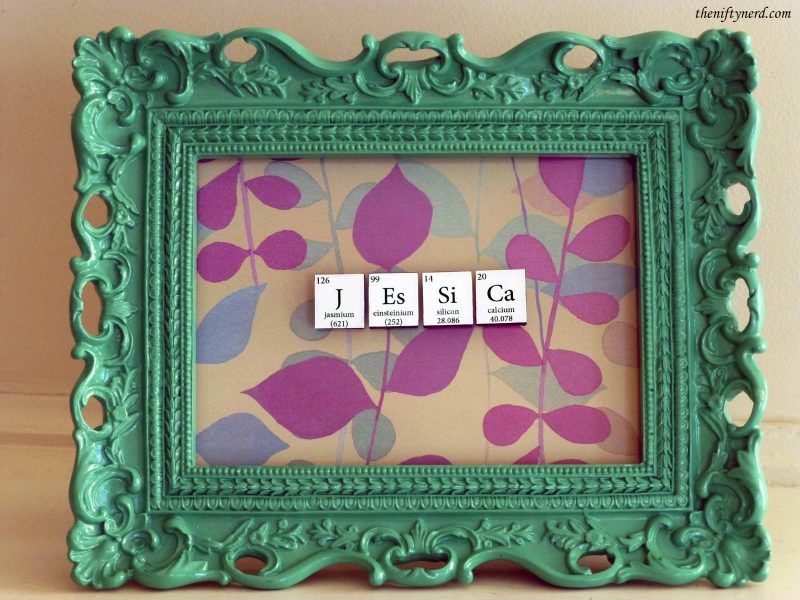Create a Custom Sign Using Periodic Table Elements
Make a cute and classy sign that’s also very nerdy with today’s craft tutorial. Learn how to make a custom sign using elements from the periodic table. This project also makes the perfect gift for a chemistry teacher or a friend who loves science.
Disclosure: This post contains affiliate links.
Supplies
- Scrabble board game letter tile
- Amazing Mold Putty
- Amazing Casting Resin (or black acrylic paint)
- Castin’ Craft color pigment
- Modge Podge
- paint brush
- E6000
- 5×7 picture frame
- colored scrapbook paper
Directions
1. Follow the directions on the Amazing Mold Putty to create molds using your Scrabble tiles (heck, if you love board games you could just use the Scrabble tiles to make your sign! 😉 )
Don’t be afraid to make thick walls using the putty so that your mold will hold up over multiple uses. I created a few molds so that I could later cast more than 1 tile in resin at a time.
I used original Scrabble game tiles and had no issue with them releasing from the putty once the mold had set. If you’d prefer larger tiles as a finished project, find another object that’s larger in size, that can be molded in place of the Scrabble tile.

2. Create your resin tiles by following the directions on the Amazing Casting Resin box. Be sure to mix your color pigment into the resin before pouring the resin into the mold.
Let the resin harden (approximately 15-20 minutes) and remove from the mold.
You can also choose to leave the tiles white, or use acrylic paint instead of resin color pigment to color your tiles (once they’ve hardened).

3. Create your periodic table element symbols. I used Adobe Illustrator to have the most control, but with patience, you could create them in Word too. I made my tile borders be 0.75 inches wide and 0.8125 inches tall.
The periodic table may not contain an element with a symbol that fits your name or word needs. In this instance, feel free to borrow from fictional fandom elements for letters such as A, D, E, G, J, L, M, Q, R, T, X, or Z:
- Adamantium (124) – The most durable substance ever to be created by scientists – used by Wolverine and others. (Marvel Comics)
- Dilithium (123) – A crystal compound that can safely combine matter and anti-matter into a stable stream. Used used to power Warp Drive engines. (Star Trek)
- Etherium (125) – An extremely rare metal created by the sphinx Crucius the Mad. Vedalken wizards strive to infuse everything with etherium. (Magic: The Gathering)
- Gundanium (119) – An almost immutable, heat-resistant, and electrically neutral material that can absorb Electro-magnetic waves. (Gundam)
- Jasmium (126) – An extra-terrestrial mineral used in alloys for incredible tensile and mechanical strength. Used to make monomolecular edged weapons. (Dune)
- Latinum (120) – A rare silver liquid, often plated with gold, used as currency by the Ferengi Alliance. (Star Trek)
- Mithril (127) – A durable silvery metal that is very light and easy to work, mined by Dwarves. From ‘mith’, grey, and ‘ril’, glitter. (Middle Earth)
- Quadium (122) – An isotope of Hydrogen with three neutrons used as a powerfull weapon. (The Mouse That Roared)
- Rearden (129) – A greenish-blue metal alloy invented by Hank Rearden. Much lighter and stronger than traditional steel. (Ayn Rand – Atlas Shrugged)
- Tyberium (121) – A typically green crystal named after the Tiber River or the emperor Tiberius. It leaches metals out of the soil into crystals leaving the landscape depleted. (Command & Conquer)
- Xenium (128) – Xen crystals (Xenium) are structures that exist in the Xen border world and appear to hold massive amounts of strong, unusual power. (Half-Life)
- Zanium (130) – A dust-like residue, characteristic of teleportation. It is a sure sign of intergalactic kidnap. (Dr. Who)

4. After you’re elements have been created, print and cut them out. Use Modge Podge to glue the slips of paper to the front of your tiles. Once dry, paint another coat on top to seal the paper.
5. Cut out a sheet of colored or patterned paper to fit in your frame as a background.
6. Use E6000 glue to secure the element tiles to the frame.

And that’s it! Your custom sign is complete. Hang on the wall or display it on a shelf with nerd pride. I promise it’ll be a great conversation starter.
Do you have any questions? Which elements will you use to create your sign? Let me know in the comments below!






This is so nerdy, I would love to do this in a new babies room or something.
That’s a super cute idea too. I love it!